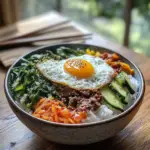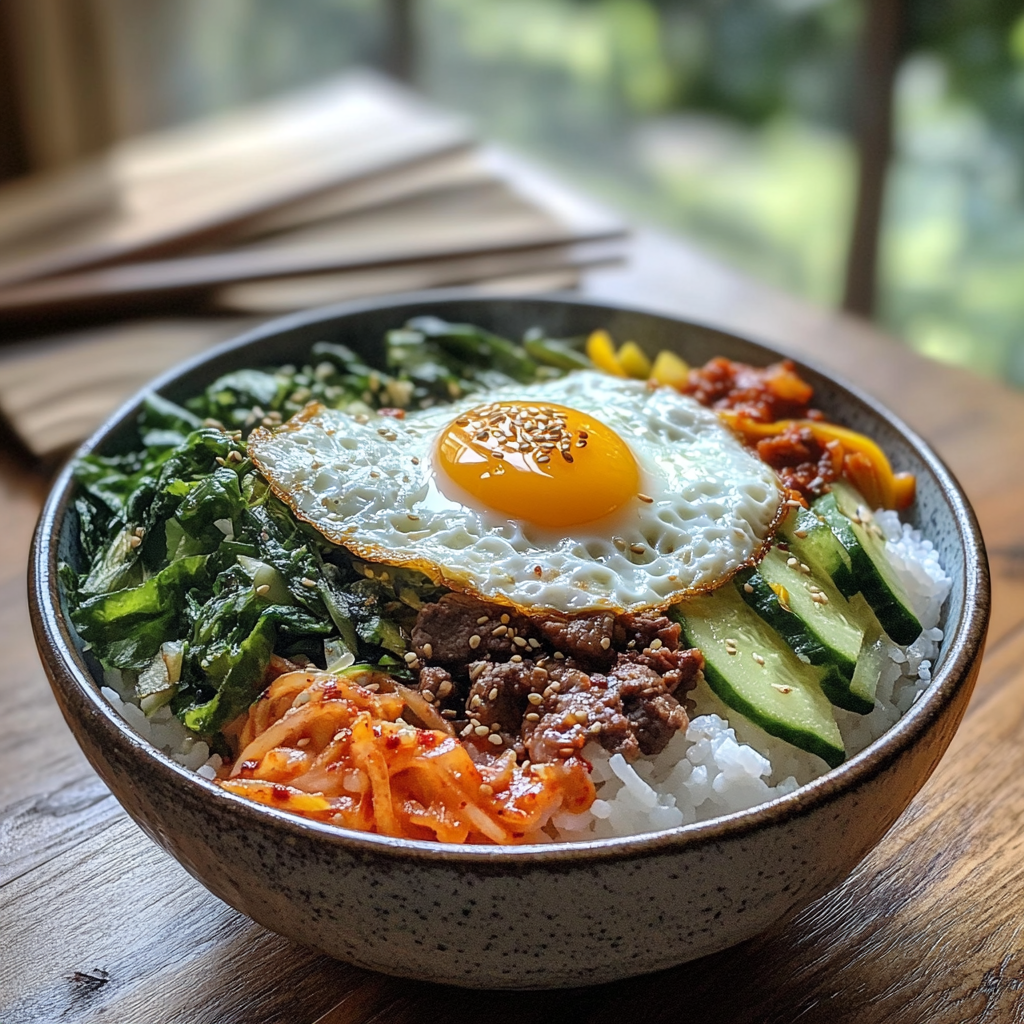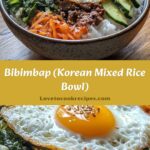Bibimbap, meaning “mixed rice” in Korean, is a vibrant and nourishing dish made with warm rice, sautéed and seasoned vegetables, a protein of choice, a fried egg, and a bold gochujang-based sauce. All elements are served in a bowl and mixed together just before eating. This traditional Korean comfort food is celebrated for its harmony of flavors, colors, and textures.
Why You’ll Love This Recipe
-
Balanced and nutritious: Includes a variety of vegetables, lean protein, and healthy fats in one bowl.
-
Fully customizable: Easily adaptable for vegetarians or those avoiding gluten.
-
Beautiful presentation: Visually striking with colorful ingredients arranged neatly on rice.
-
Easy meal prep: Each component can be made in advance for a quick assembly later.
-
Deliciously satisfying: A mix of savory, spicy, and umami flavors that create a complete and comforting meal.
Ingredients
(Tip: You can find the complete list of ingredients and their measurements in the recipe card below.)
For the Rice:
-
Short-grain white rice
For the Vegetables (can vary based on preference):
-
Carrots, julienned
-
Zucchini, julienned
-
Bean sprouts
-
Spinach
-
Shiitake mushrooms, sliced
-
Cucumber, thinly sliced
-
Sesame oil
-
Salt
For the Protein (choose one):
-
Ground beef, sirloin, or ribeye, thinly sliced
-
Chicken or tofu as alternatives
For Beef Marinade:
-
Soy sauce
-
Sesame oil
-
Garlic, minced
-
Sugar
-
Ground black pepper
For the Sauce:
-
Gochujang (Korean chili paste)
-
Sesame oil
-
Sugar
-
Water
-
Rice vinegar (optional)
For Assembly:
-
Eggs (fried, sunny-side up)
-
Sesame seeds
-
Optional: seaweed strips, kimchi
Directions
-
Cook the rice: Prepare short-grain rice according to package instructions and set aside.
-
Marinate the meat (if using beef or chicken): Mix soy sauce, sesame oil, minced garlic, sugar, and black pepper. Add the sliced meat and marinate for 30 minutes.
-
Prepare the vegetables:
-
Blanch spinach and bean sprouts briefly in boiling water. Squeeze out excess moisture and season lightly with sesame oil and salt.
-
Sauté carrots, zucchini, and mushrooms separately with a little sesame oil and a pinch of salt until tender.
-
Keep cucumber raw for a crisp contrast.
-
-
Cook the protein: Sauté the marinated beef or chicken in a pan over medium-high heat until fully cooked.
-
Fry the eggs: Cook the eggs sunny-side up so the yolk stays runny, adding creaminess to the dish once mixed.
-
Make the sauce: In a small bowl, combine gochujang, sesame oil, sugar, and a bit of water to thin. Adjust to your taste.
-
Assemble: Place a portion of rice in a bowl. Neatly arrange the cooked vegetables and protein around the top. Add the fried egg in the center and drizzle the gochujang sauce over everything. Sprinkle with sesame seeds.
-
Mix and enjoy: Before eating, mix all ingredients together in the bowl for a flavorful bite every time.
Servings and Timing
-
Yield: Serves 4
-
Prep Time: 25 minutes
-
Cook Time: 20 minutes
-
Total Time: 45 minutes
Variations
-
Vegetarian Bibimbap: Skip the meat and add tofu or more mushrooms for a plant-based version.
-
Spicy seafood version: Use sautéed shrimp or squid in place of beef.
-
Brown rice or quinoa: Use whole grains for added nutrition.
-
Raw egg yolk: For authenticity, use a raw yolk instead of a cooked egg—only with pasteurized eggs.
Storage and Reheating
-
Storage: Store leftover components separately in airtight containers in the refrigerator for up to 3 days.
-
Reheating: Reheat rice, meat, and sautéed vegetables in the microwave or a skillet. Reassemble the bowl and top with a freshly fried egg.
-
Freezing: Avoid freezing as the texture of vegetables and rice may degrade.
FAQs
What does “bibimbap” mean?
Bibimbap literally means “mixed rice” in Korean, referring to the way the dish is eaten.
Can I use regular long-grain rice?
Short-grain white rice is traditional and preferred for texture, but long-grain rice can be used if needed.
Is bibimbap supposed to be spicy?
It can be. The level of spiciness depends on how much gochujang sauce is added.
Can I make bibimbap without gochujang?
Yes, though gochujang gives it its signature flavor. You can use soy sauce with a touch of chili and sugar as a substitute.
What protein works best for bibimbap?
Thinly sliced beef is most common, but chicken, pork, tofu, or seafood can also be used.
Do I have to cook all the vegetables separately?
Cooking each vegetable separately helps preserve their color and texture, but you can simplify by sautéing them together if preferred.
Is bibimbap gluten-free?
Traditional recipes contain soy sauce and gochujang, which may have gluten. Use gluten-free versions to make the dish gluten-free.
Can I make this dish in advance?
Yes, all the components can be made ahead of time and assembled when ready to eat.
What kind of pan should I use?
Any sauté pan works for the components, but for a crispy rice bottom, serve it in a hot stone bowl (dolsot).
What do I serve with bibimbap?
It pairs well with kimchi, miso soup, or a simple broth-based soup for a full Korean meal.
Conclusion
Bibimbap is a versatile and satisfying dish that brings the best of Korean cuisine into one colorful bowl. With its medley of textures, nutritious ingredients, and deeply savory flavors, it’s a recipe you can enjoy for both everyday meals and special occasions. Whether you’re sticking to tradition or putting your own twist on it, bibimbap always delivers a delicious experience.

Bibimbap (Korean Mixed Rice Bowl)
- Author: Sarra
- Prep Time: 25 minutes
- Cook Time: 20 minutes
- Total Time: 45 minutes
- Yield: 4 servings 1x
- Category: Main Course
- Method: Sautéing
- Cuisine: Korean
Description
Bibimbap is a vibrant and nourishing Korean rice bowl dish featuring steamed rice topped with a colorful assortment of sautéed vegetables, seasoned beef (or tofu), a fried egg, and a generous dollop of spicy-sweet gochujang sauce. Everything is mixed together just before eating, creating a harmony of flavors and textures. Perfect for lunch or dinner, and easy to customize for different diets.
Ingredients
- For the Bowl
- 2 cups cooked white or brown rice
- 1 cup spinach, blanched and seasoned
- 1 cup bean sprouts, blanched and seasoned
- 1 cup carrots, julienned and sautéed
- 1 cup zucchini, julienned and sautéed
- 1 cup shiitake mushrooms, sliced and sautéed
- 1 cup ground beef or tofu, cooked and seasoned
- 4 eggs
- Vegetable oil, for cooking
- Sesame seeds, for garnish
- For the Gochujang Sauce
- 2 tbsp gochujang (Korean chili paste)
- 1 tbsp sesame oil
- 1 tbsp water
- 1 tbsp rice vinegar
- 1 tsp sugar
- 1 tsp minced garlic
Instructions
- Prepare rice and keep warm.
- Cook each vegetable separately in a lightly oiled pan with a pinch of salt, then set aside.
- Cook the beef or tofu with soy sauce, garlic, and sesame oil until fully cooked.
- Fry eggs sunny-side-up in a lightly oiled skillet.
- Mix all sauce ingredients in a small bowl until smooth.
- To assemble, place warm rice in bowls. Arrange vegetables and beef/tofu neatly on top.
- Add the fried egg to the center and drizzle with gochujang sauce.
- Sprinkle with sesame seeds and mix everything together before eating.
Notes
- You can make this dish vegetarian by using tofu or mushrooms instead of beef. Adjust spice level by increasing or decreasing the gochujang. Prepping vegetables ahead makes assembly quick and easy.
Nutrition
- Calories: 480
- Sugar: 6g
- Sodium: 620mg
- Fat: 18g
- Saturated Fat: 4g
- Unsaturated Fat: 12g
- Trans Fat: 0g
- Carbohydrates: 58g
- Fiber: 5g
- Protein: 22g
- Cholesterol: 185mg



Your email address will not be published. Required fields are marked *